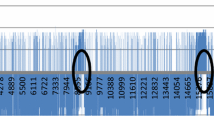Summary
Two independent study-groups, one in Britain and the other in the United States, were the first to report linkage between APC and a TaqI restriction fragment length polymorphism (RFLP) at D5S71 (probe C11p11) on chromosome 5q. They found no recombinants in about 50 informative meioses. The same TaqI RFLP was found to be uninformative for linkage in 15 Dutch polyposis families. The recently reported four base-pair deletion polymorphism (DEL1) at D5S71 has raised the polymorphism information content of this marker from 0.17 to 0.40 in the Dutch population. Seven of 20 polyposis families screened for the DEL1 as well as the TaqI polymorphism gave a combined peak lod score of 5.68 with no recombinants in 37 informative meioses. These data, together with those so far reported in the literature, raise the peak lod score to 17.09 at a recombination fraction of 0.05, the 95% upper confidence limit being 0.09. In combination with the use of another informative marker, D5S81 (probe YN5.48) closely mapping on the other side of APC, the presymptomatic diagnosis of the disease can be made with more than 99.9% certainty. It has to be stressed, however, that the the possible existence of more than one polyposis locus cannot, as yet, be excluded.
Similar content being viewed by others
References
Aldred MA, Rees M, Tsioupra K, Leigh SEA, Neale KF, Delhanty JDA (1988) Familial polyposis coli. Lancet II:565.
Baker RH, Heineman MH, Miller HH, Decosse JJ (1988) Hyper-pigmented lesions of the retinal pigment epithelium in familial adenomatous polyposis. Am J Med Genet 31:427–435.
Bodmer WF, Baily CJ, Bodmer J, Bussey HJR, Ellis A, Gorman P, Lucibello FC, Murday VA, Rider SH, Scambler P, Sheer D, Solomon E, Spurr NK (1987) Localization of the gene for familial adenomatous polyposis on chromosome 5. Nature 328:614–616.
Breukel C, Tops CMJ, Meera Khan P (1989a) Four-base-pair deletion polymorphism at D5S71 (C11p11) linked to APC in the human chromosome 5q21–q22 region. Nucleic Acids Res 17:10512.
Breukel C, Tops CMJ, Meera Khan P (1989b) A 4 base-pair deletion polymorphism in man. J Genet 68:171–183.
Bülow S (1987) Familial adenomatous polyposis. Dan Med Bull 34:1–15.
Bussey HJR (1975) Familial polyposis coli. Johns Hopkins University Press, Baltimore.
Chapman PD, Church W, Burn J, Gunn A (1989) Congenital hypertrophy of retinal pigment epithelium: a sign of familial adenomatous polyposis. Br Med J 298:353–354.
Conneally PM, Edwards JH, Kidd KK, Lalouel JM, Morton NE, Ott J, White R (1985) Report of the committee on methods of linkage and reporting. (8th International Workshop on Human Gene Mapping) Cytogenet Cell Genet 40:356–358.
Dunlop MG, Steel CM, Wyllie AH, Bird CC, Evans HJ (1989) Linkage analysis in familial adenomatous polyposis: order of C11p11 (D5S71) and Pi227 (D5S37) loci at the APC gene. Genomics 5:350–353.
Lathrop GM, Lalouel (1984) Easy calculations of lodscores and genetic risks on small computers. Am J Hum Genet 36:460–465.
Lau YL, Levinsky RJ, Malcolm S, Goodship J, Winter R, Pembrey M (1988) Genetic prediction in X-linked agammaglobulinaemia. Am J Med Genet 31:437–448.
Leppert M, Dobbs M, Scambler P, O'Connell P, Nakamura Y, Stauffer D, Woodward S, Burt R, Hughes J, Gardner E, Lathrop M, Wasmuth J, Lalouel M, White R (1987) The gene for familial polyposis coli maps to the long arm of chromosome 5. Science 238:1411–1413.
Meera Khan P, Tops CMJ, Broek M v d, Breukel C, Wijnen JT, Oldenburg M, Bos J v d, Leeuwen-Cornelisse ISJ v, Vasen HFA, Griffioen G, Verspaget HM, Hartog Jager FCA den, Lamers CBHW (1988) Close linkage of a highly polymorphic marker (D5S37) to familial adenomatous polyposis (FAP) and confirmation of FAP localization on chromosome 5q21–22. Hum Genet 79:183–185.
Nakamura Y, Lathrop M, Leppert M, Dobbs M, Wasmuth J, Wolff E, Carlson M, Fujimoto E, Krapcho K, Sears T, Woodward S, Hughes J, Burt R, Gardner E, Lalouel JM, White R (1988) Localization of the genetic defect in familial adenomatous polyposis within a small region of chromosome 5. Am J Hum Genet 43:638–644.
Tops CMJ, Griffioen G, Vasen HFA, Breukel C, Klift HMvd, Wijnen JT, Leeuwen ISJv, Hartog Jager FCA den, Nagengast FM, Lamers CBHW, Meera Khan P (1989) Presymptomatic diagnosis of familial adenomatous polyposis by bridging DNA markers. Lancet II: 1361–1363.
Traboulsi EI, Maumenee IH, Krush AJ, Alcorn D, Giardiello FM, Burt RW, Hughes P, Hamilton SR (1990) Congenital hypertrophy of the retinal pigment epithelium predicts colorectal polyposis in Gardner's syndrome. Arch Ophthalmol 108:525–526.
Vasen HFA, Griffioen G, Offerhaus GJA, Hartog Jager FCA den, Leeuwen-Cornelisse ISJ van, Meera Khan P, Lamers CBHW, Slooten EA van (1990) The value of screening and central registration of families with familial adenomatous polyposis. Dis Colon Rectum 33:227–230.
Author information
Authors and Affiliations
Rights and permissions
About this article
Cite this article
Tops, C.M.J., Breukel, C., van der Klift, H.M. et al. A new deletion polymorphism at D5S71 raises the linkage information on adenomatous polyposis coli: implications for presymptomatic diagnosis. Hum Genet 86, 365–368 (1991). https://doi.org/10.1007/BF00201835
Received:
Revised:
Issue Date:
DOI: https://doi.org/10.1007/BF00201835




